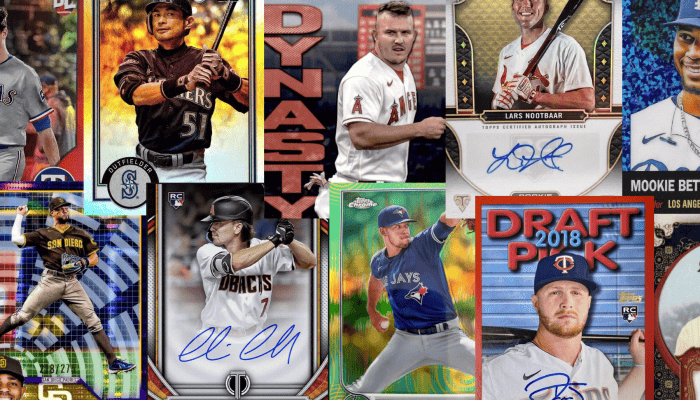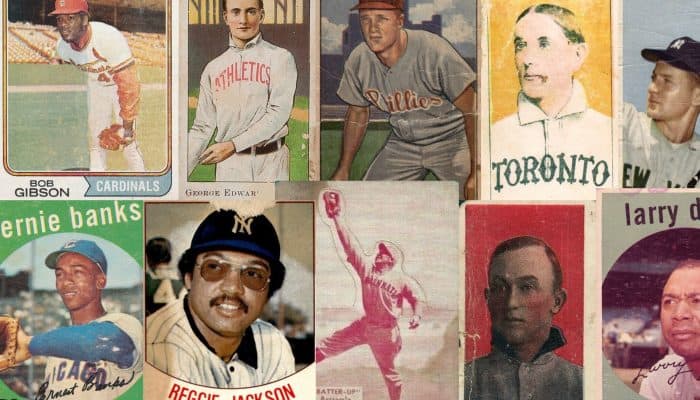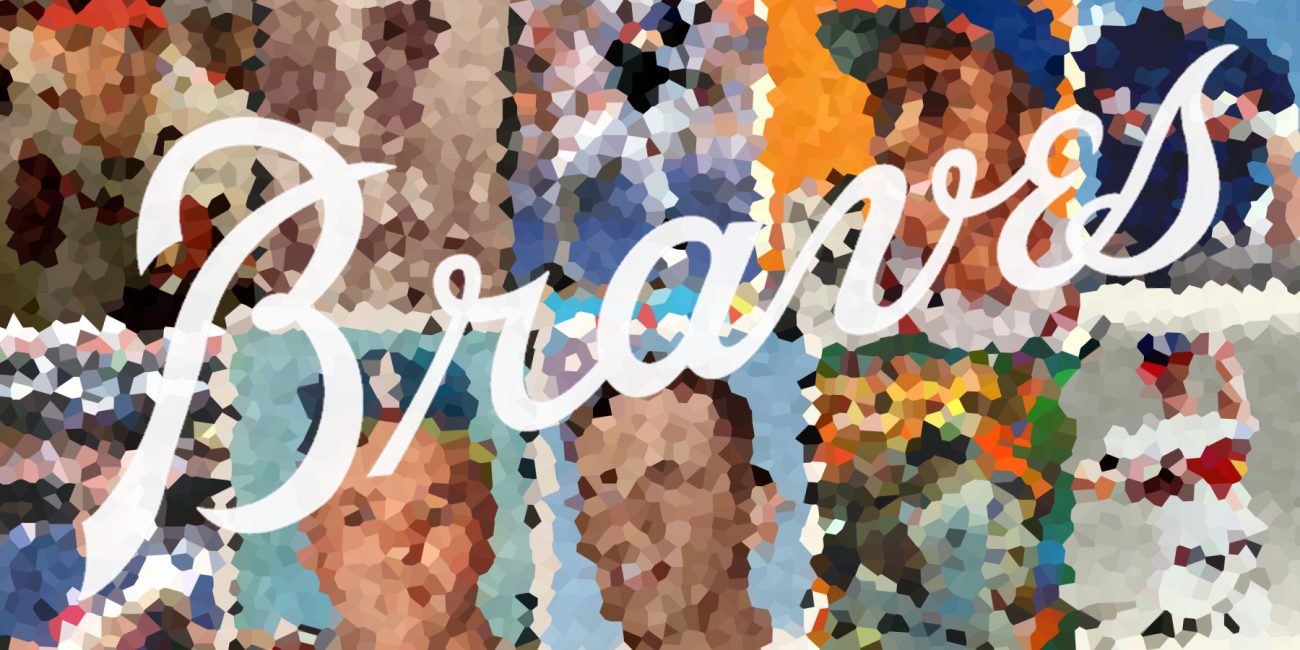
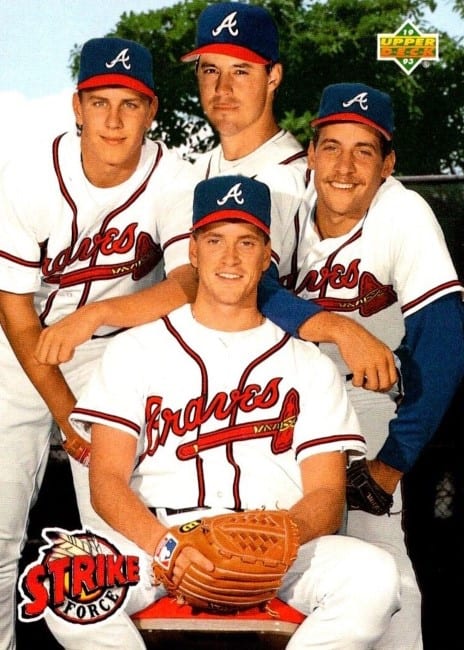
What’s the oldest baseball franchise? You’d be excused for answers like the White Sox, the Cubs and the Reds, but the correct answer is the Atlanta Braves.
The Atlanta Braves franchise has a storied history that traces its roots back to 1871 when it was originally established in Boston as the Red Stockings. In 1914, the Boston Braves won the first of the franchise’s four World Series championships. Over the years, the team underwent several relocations and name changes before settling in Atlanta in 1966.
Fans who grew up in the 1980s or later could be forgiven for thinking this proud franchise was always a juggernaut, but in fact, the Braves experienced very little success outside of back-to-back championships in 1957 and 1958. Over a period of 90 years from 1900-1990, they only finished in 1st place in the National League six times. The Braves achieved their first taste of sustained success in the 1990s, capturing an impressive 14 consecutive division titles from 1991 to 2005 under the leadership of manager Bobby Cox. They won the World Series in 1995, and again in 2021.
The Braves’ legacy is one of perseverance, highlighted by their ability to evolve and adapt, ultimately solidifying their place as a respected and accomplished franchise in Major League Baseball.
A lot of baseball history lives in those Braves uniforms. Here are the top 10 Braves players of all-time, and one must-have card for each of them:
10. John Smoltz
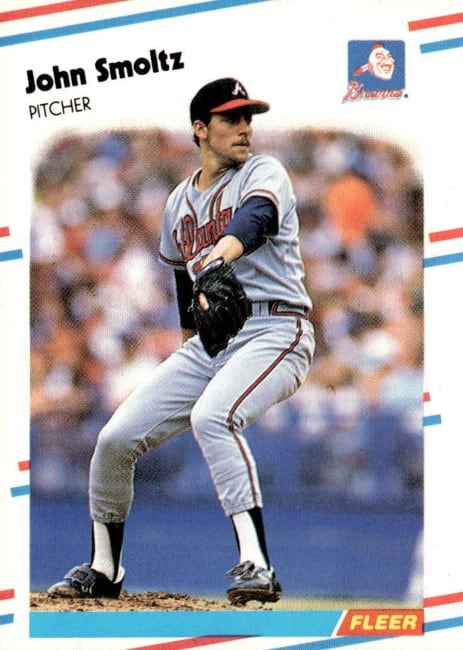
John Smoltz contributed significantly to the team’s success during his illustrious Braves career that spanned three decades. Spending the majority of his career with the Braves, Smoltz showcased remarkable versatility as both a starter and a closer. He formed one-third of the legendary trio alongside Greg Maddux and Tom Glavine, forming one of the most dominant pitching rotations in baseball history.
As a starting pitcher, Smoltz played a pivotal role in the Braves’ 1995 World Series victory, earning the series MVP for his outstanding performance. His pitching arsenal included a devastating fastball and a sharp slider, making him a formidable force on the mound. Smoltz’s individual accomplishments include eight All-Star selections and the 1996 National League Cy Young Award when he posted a remarkable 24-8 record.
In a remarkable twist, Smoltz transitioned to the role of a closer in 2001, becoming one of the most dominant relievers in the league. He saved 55 games that season and demonstrated his ability to adapt and excel in different roles. In 2005, after three successful years as a reliever, Smoltz transitioned back into a starting role. This transition highlighted his commitment to team success.
Smoltz’s leadership and competitive spirit left an indelible mark on the Braves’ franchise. He was inducted into the Hall of Fame in 2015.
Best Braves card: 1988 Fleer Update John Smoltz (RC) #U-74
Smoltz’s true rookie card isn’t from Topps, Bowman or any of the other big names – it’s from the 1988 Fleer Update set. The mainly white card shows Smoltz in his wind-up, his first in a Braves uniform. The card sells for $150-$300 in mint, graded condition. Ungraded examples are closer to $30-$50, making this Smoltz card attainable for collectors.
9. Dale Murphy
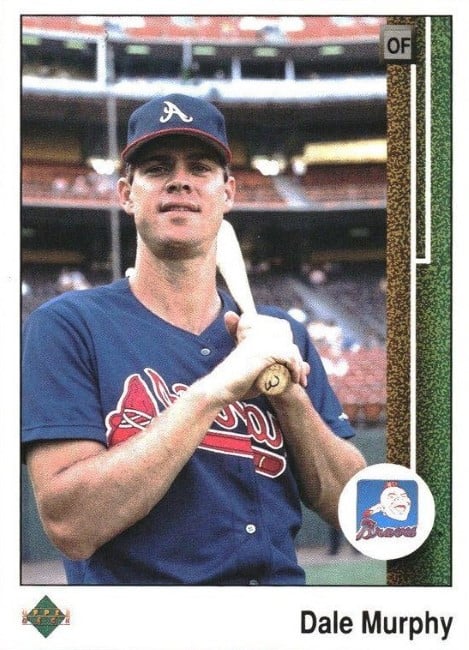
Dale Murphy is a beloved figure in Braves history. Murphy spent 15 of his 19 years in Atlanta, including a remarkable stretch from 1982-1987 in which he twice won the National League Most Valuable Player award, and finished in the top 10 two additional years. Murphy epitomized excellence during his tenure with the Braves. His offensive prowess and defensive skills in the outfield made him a fan favorite and a cornerstone of the franchise during the 1980s.
Murphy’s peak seasons were extraordinary. He led the National League in home runs for two consecutive years (1984 and 1985) and also claimed five Gold Glove Awards for his outstanding defensive play. His leadership qualities were evident as he served as the team captain, guiding the Braves through both triumphs and challenges. Murphy’s impact on the community was equally significant, earning him the prestigious Roberto Clemente Award in 1988 for his humanitarian efforts.
While Murphy and the Braves fell short of a World Series title during his tenure, his individual accolades and influence on the team’s culture remain undeniable. A seven-time All-Star, Murphy’s legacy endures in the hearts of Braves fans. Dale Murphy was inducted into the Hall of Fame in 1995.
Best Braves card: 1989 Upper Deck Reverse Negative Dale Murphy #357
As with the next player on this list, Murphy’s early cards were all gridded, group format. Therefore, this card was chosen for its mystique in the hobby – originally, Upper Deck accidentally released this card with a reversed negative. They quickly corrected it, and they estimate that only 2% of Murphy’s 1989 cards carry this error. Murphy even signed one backwards. Most versions sell in the $50-$150 range.
8. Phil Niekro
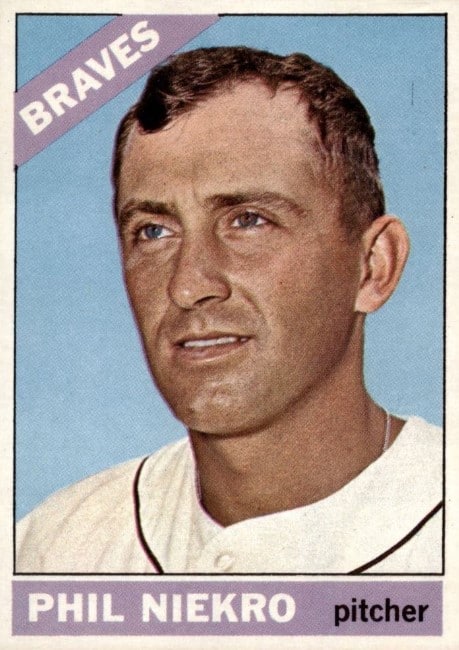
Phil Niekro, nicknamed “Knucksie,” was a legendary knuckleball pitcher who played for 21 seasons for the Braves as part of his 25 year career. Joining the Milwaukee Braves in 1966, Niekro became a stalwart of the pitching staff, and his signature pitch, the fluttering knuckleball, baffled hitters and contributed to his impressive longevity in the game. His accomplishments with baseball’s most mysterious pitch paved the way for future knuckleballers like Tim Wakefield.
Niekro’s impact on the Braves was profound, earning five All-Star selections during his tenure. He led the National League in victories twice and in complete games four times, showcasing his durability and effectiveness on the mound. Niekro ranks 16th on MLB’s all-time wins list with 318 career victories, and he is the only knuckleballer to win 300 or more major league games. Niekro was also a pitcher who could be counted on; he started 716 games, which is 5th all-time.
A fan favorite, Niekro’s success extended beyond individual accomplishments. Even when he moved on to New York, he said, “I was still thinking about the Atlanta Braves almost every day.” He eventually signed a one-day contract and retired as a Brave in 1987.
Niekro’s impact on the Braves franchise is immeasurable. Phil Niekro was inducted into the Hall of Fame in 1997.
Best Braves card: 1966 Topps Phil Niekro #28
Niekro’s first major league cards were in 1964 and 1965, but he shared those with teammates Phil Roof and Clay Carroll. Had they gone on to a Hall of Fame career, we’d feel comfortable choosing that card; however, the 1966 Topps – Niekro’s first solo card – is the best. The card is spartan, but features a nice portrait of Niekro, who was 27 at the time. This card is not rare, and while you will pay $150-$300 for a mint, graded version, ungraded versions are available for $50-$100.
7. Tom Glavine
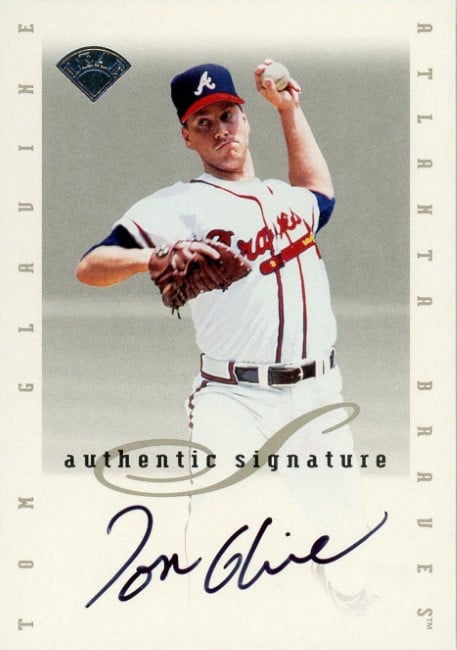
Tom Glavine was a key member of the Braves’ dominant pitching rotation in the 1990s. Joining the Braves in 1987, with the club in the midst of seven straight losing seasons, Glavine quickly established himself as a premier left-handed pitcher in the league. His precise control and ability to change speeds made him a formidable force on the mound.
Glavine won two Cy Young awards but finished in the top of 3 of voting a staggering six times. An eight-time All-Star with Atlanta, Glavine’s career with the Braves also included five 20-win seasons. He also won 244 games in his Braves career (and 305 total). He’s tied with Eddie Plank for the 3rd-most wins among left-handed pitchers.
He was one-third of the legendary pitching trio of Maddux-Smoltz-Glavine, who contributed significantly to the Braves’ World Series championship in 1995, for which he earned World Series MVP honors. In the decisive Game 6, Glavine threw eight scoreless innings and allowed only one hit.
Beyond statistics, Tom Glavine’s leadership and professionalism were invaluable to the Braves’ success. His ability to perform under pressure solidified his legacy as one of the all-time greats. Glavine was a first-ballot Hall of Famer, inducted in 2014.
Best Braves card: 1996 Leaf Signature Tom Glavine #60
Leaf’s first foray into autographed cards was the 1996 set, which featured myriad superstars. The design is minimalistic, giving a clean space for the autograph, and it doesn’t look dated. Glavine’s card is special because the print run was only 25% of the other cards (5,000 copies), making it much harder to find. Nevertheless, his card can be found in ungraded form for around $150, and twice that for a mint, graded version.
6. Chipper Jones
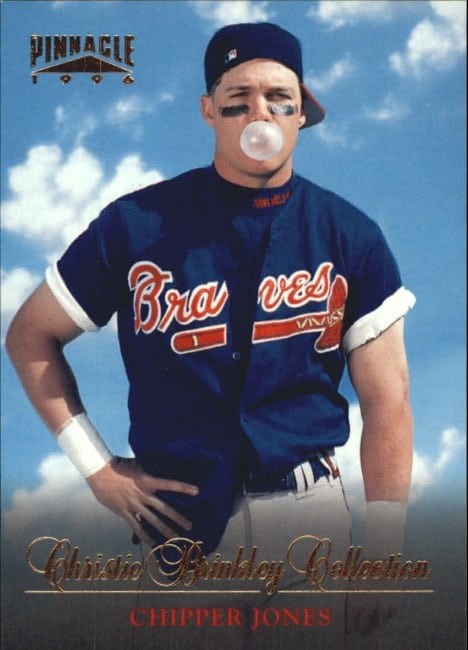
Chipper Jones spent his entire 19-season career with the Braves. Drafted as the first overall pick in 1990, Jones quickly became a cornerstone of the Braves’ success in the 1990s and 2000s. His offensive prowess, defensive skills, and leadership qualities made him a beloved figure among Braves fans. Jones’ switch-hitting ability and consistent performance at the plate contributed significantly to the team’s offensive firepower.
A key component of the Braves’ dominance in the 1990s, Chipper Jones was a driving force behind the team’s 1995 World Series championship. His career achievements include eight All-Star selections, a National League MVP award in 1999, and a batting title in 2008. He hit 468 career home runs and 2,726 – both just shy of the historic marks of 500 HR / 300 hits. His lifetime OBP was .400, proving he wasn’t just a power hitter.
Jones’ versatility was evident as he transitioned from playing third base to the outfield and back to third base during his career. In the prime of his career, he averaged 157 games per year, showing his durability and dependability.
Jones retired as one of the greatest switch-hitters in baseball history, leaving an enduring legacy in Atlanta. Chipper Jones was inducted into the Hall of Fame in 2018.
Best Braves card: 1996 Pinnacle Christie Brinkley Collection Chipper Jones #5
Collectors have trouble agreeing on Jones’s “true” rookie card, since his earliest cards are actually prospect and minor league cards (a problem we get with modern baseball, which has led to companies using designations like “1st Bowman”).
We’re not going to choose a horse in that race; instead, we chose the 1996 Pinnacle Christie Brinkley Collection #5 because you just can’t get more 90s than this. The card shows Jones blowing a bubble, with an untucked shirt and backwards hat. Brinkley – not just a supermodel – took all of the photos on the 16 cards, creating a “Dream Team” for fans. Jones’s card is worth around $25-$50.
5. Kid Nichols
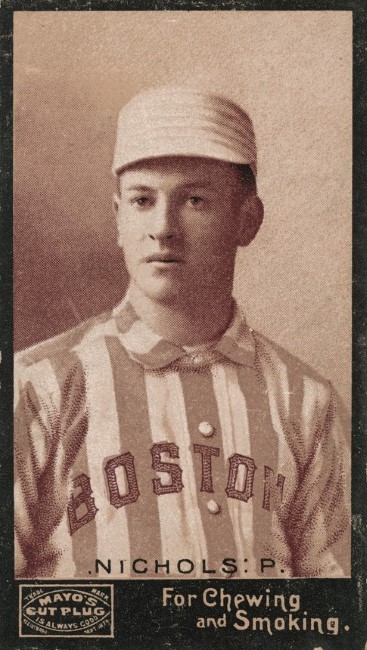
Charles Augustus Nichols – nicknamed “Kid” because he entered professional baseball at a young age – was a pioneer of early baseball. Joining the Boston Beaneaters, the precursor to the Atlanta Braves, in 1890, Nichols quickly became a dominant force on the mound. His remarkable durability and consistency during an era of grueling schedules set him apart. Nichols recorded an astounding 30 or more victories in seven consecutive seasons (1891-1897), showcasing his unparalleled effectiveness, albeit in a time when pitchers would throw nearly every day.
Nichols was known for his pitching prowess, and he used various techniques to deceive batters. He was one of the first pitchers to master the “slow ball,” a pitch that relied on change of speed rather than overpowering velocity. Now, change-ups are standard fare in a pitcher’s repertoire.
Nichols’ impact on the Braves’ franchise was profound, leading the team to five pennants and a victory in the 1892 Temple Cup. His 361 career victories with the Boston Beaneaters remain a franchise record. Nichols’ success was not only measured in wins but also in his ability to perform at a high level in crucial moments. His legacy as one of the early stars of baseball and a key figure in Braves history endures.
Kid Nichols was inducted into the Hall of Fame in 1949, recognizing his contributions to the game during the formative years of professional baseball.
Best Braves (Beaneaters) baseball card: 1895 Mayo’s Cut Plug Kid Nichols
There are only a handful of cards featuring Nichols in a Boston uniform, and this one is the most common (relatively speaking – it’s over 125 years old). The card is small in size (only 1-⅝ by 2-⅞) and features Nichols in a striped Beaneaters uniform with a round cap. When you can find it, this card sells for $5,000-$7,500 in graded “poor” condition. If you’re looking for a more affordable offering, try the legendary 1961 Fleer #129, which came out 55 years after Nichols’ last game.
4. Greg Maddux
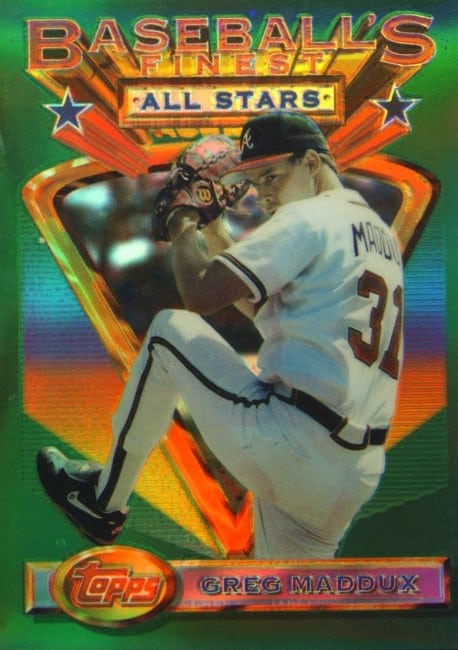
Greg Maddux, a master of precision and control on the mound, played a pivotal role in the Braves’ pitching dominance during the 1990s. Acquired by the Braves in 1993, Maddux became the linchpin of a formidable pitching rotation. Known for his exceptional command, Maddux’s ability to locate pitches with pinpoint accuracy and outthink hitters made him one of the most successful pitchers in the history of the game.
Maddux’s tenure with the Braves yielded numerous accolades, including three Cy Young Awards in consecutive years (1993-1995). His four consecutive National League ERA titles (1993-1996) underscored his consistency and dominance. Maddux’s brilliance reached its zenith during the Braves’ 1995 World Series victory.
Maddux’s baseball IQ and work ethic set a standard for excellence in the Braves’ organization. He is famous for saying that his approach to pitching to Barry Bonds was to walk him – a funny quote, but also indicative of his thoughtful approach to pitching. “You have to get 27 outs,” he said at the time.
Beyond the statistics, Maddux’s influence extended to the entire pitching staff, and his impact on the game is celebrated by fans and peers alike. Greg Maddux was inducted into the Hall of Fame in 2014, alongside teammate Tom Glavine.
Best Braves card: 1993 Topps Finest Refractor Greg Maddux #85
We can’t choose a rookie card here because Maddux began his career with the Cubs; therefore, his inclusion in the 1993 Topps Finest refractor set – which set the tone for a future filled with shiny, premium refractor parallels – is the winner. Maddux joins many other stars of the 90s in this tone-setting set. Prices vary wildly, with some sellers asking $1,000-$2,000 for graded versions, while ungraded versions cost significantly less.
3. Eddie Mathews
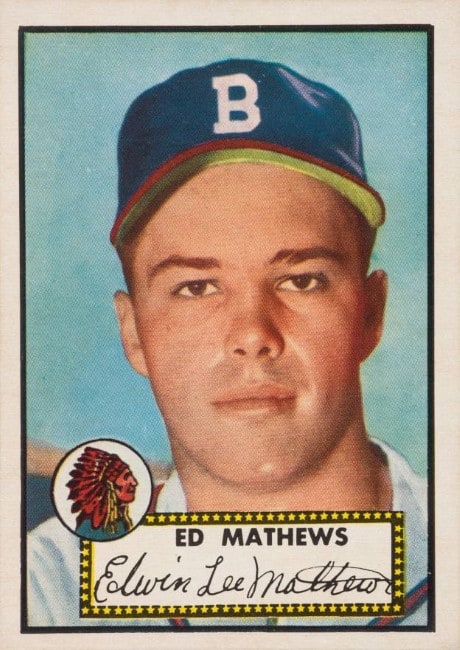
Eddie Mathews, a formidable force in the lineup of the Milwaukee and Atlanta Braves, played an essential role in the team’s success during his tenure. Joining the Milwaukee Braves in 1952, Mathews quickly emerged as one of the premier power-hitters of his era. A nine-time All-Star, Mathews combined raw power with a keen eye for the strike zone, making him a constant offensive threat. His impact was evident not only in his ability to hit for both average and power but also in his defensive skills at third base.
During his career with the Braves, Mathews accumulated impressive statistics, including 512 home runs. In 1957, he played a crucial role in leading the Braves to a World Series championship. He was a three-time home run champion and a two-time National League home run leader, solidifying his status as one of the most feared sluggers of his time. He finished in the top 10 of MVP voting four times, finishing second to Roy Campanella when he was just 21, and second to Ernie Banks in 1959.
Mathews’s impact on the Braves extended beyond statistics; he was a key component of the team’s identity during a period of transition from Milwaukee to Atlanta. He formed a formidable trio with Hank Aaron and Warren Spahn, becoming a linchpin in the team’s success during the 1950s and 1960s. Mathews’ versatility was demonstrated by his willingness to switch positions, playing third base, first base and even the outfield during different phases of his career. His consistent performance at the plate and reliability in the field made him an indispensable part of the Braves’ lineup.
Eddie Mathews was inducted into the Baseball Hall of Fame on August 1, 1978, recognizing his exceptional contributions to the game and his legacy as one of the greatest third basemen in baseball history.
Best Braves card: 1952 Topps Eddie Mathews (RC) #407
It’s hard to beat a rookie card from the iconic 1952 set, and one that is arguably the second most-valuable at that. This Eddie Mathews card is also a high-numbered short print, making it even more coveted. So far, no PSA 10s of this card exist, but a PSA 8 sold for $161,000. Ungraded or in poor condition, you can still expect to pay $5,000-$10,000 for Mathews’s rookie.
If you want something a little cheaper, the 1953 Topps #37 is a worthy runner-up, valued around $1,000 for a PSA 7 or PSA 8 (again, no PSA 10s are known to exist).
2. Warren Spahn
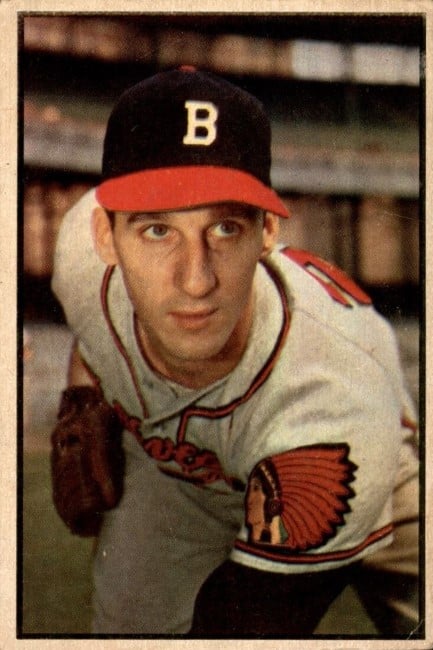
Warren Spahn, a legendary left-handed pitcher, stands as a towering figure in the history of the Atlanta Braves franchise. Joining the Boston Braves in 1942, Spahn’s early career was interrupted by military service during World War II, but upon his return in 1946, he embarked on a remarkable journey that would solidify his status as one of the greatest pitchers in baseball history.
Spahn’s time with the Braves spanned over two decades, and his impact on the team’s pitching staff was nothing short of extraordinary. His career highlights include an amazing 363 victories, making him the winningest left-handed pitcher in the history of the game. Spahn also holds the record for most wins in modern baseball history (Greg Maddux is 2nd). A 17-time All-Star, Spahn’s contributions were instrumental in leading the Braves to two National League pennants and a World Series title in 1957.
Spahn’s legendary career with the Braves earned him the Cy Young Award in 1957, and he played a crucial role in the team’s success during its formative years in Milwaukee. He was so legendary that the rhyme, “Spahn and Sain, pray for rain” became a popular saying in the 1940s, which meant that the Braves would rather let Warren Spahn and Johnny Sain, his teammate, pitch, and then hope that games were rained out until they were healthy enough to pitch again.
Warren Spahn was inducted into the Baseball Hall of Fame in 1973, recognizing his exceptional contributions to the game and his place among the pantheon of baseball immortals. His legacy as a Braves icon and one of the greatest left-handed pitchers of all time endures as a testament to his enduring impact on the sport.
Best Braves card: 1953 Bowman Warren Spahn #99
Topps and Bowman made some beautiful cards in the 50s and, since Spahn doesn’t have a “true rookie” (he debuted in 1942, before the mainstream sets came out in 1948), his best card is clearly his 1953 Bowman #99. It’s a full color photo of Spahn in his follow-through, with the Braves logo on his sleeve and cap logo shown prominently. His glove – that old 50s style – is barely visible in the background.
If you want a winner (a 363 game winner), this is it. The card is also affordable, with PSA 5 to PSA 7 versions selling around $300-$600.
1. Hank Aaron
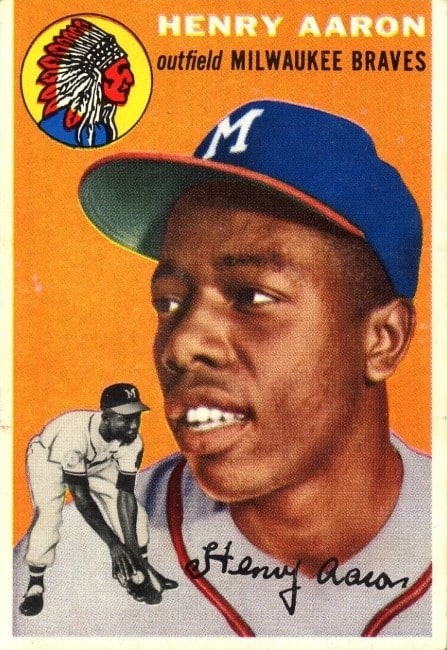
Henry “Hank” Aaron, an icon in the world of baseball, is one of the most iconic baseball players of all time. Joining the Milwaukee Braves in 1954, Aaron quickly established himself as a prolific hitter, showcasing a combination of power and consistency that set him apart from his peers. His swing was a thing of beauty, and his ability to drive the ball with authority made him a perennial offensive threat.
Aaron’s career with the Braves was highlighted by numerous accolades, including 24 consecutive All-Star selections for the Braves, three Gold Glove Awards, and the 1957 National League MVP. In that same year, he played a pivotal role in leading the Braves to a World Series championship, a testament to his ability to perform on the grandest stage.
However, it was Aaron’s pursuit and eventual surpassing of Babe Ruth’s home run record that etched his name in the annals of baseball history. On April 8, 1974, with his 715th home run, Aaron surpassed Ruth’s long-standing mark, solidifying his status as the all-time home run king. Aaron also holds the MLB record for extra base hits, total bases and RBIs.
Beyond the statistical achievements, Aaron’s impact on the Braves transcended the field. In an era marked by racial tension and adversity, Aaron faced immense pressure and scrutiny with grace and determination. His journey to breaking the home run record became a symbol of perseverance and resilience, earning him admiration not only as a baseball player but also as a civil rights icon. Hank Aaron’s legacy as a Brave is one of unparalleled excellence and quiet strength.
Hank Aaron was inducted into the Baseball Hall of Fame in 1982. His influence on the Braves and the broader baseball community endures, and his legacy as one of the greatest players in the history of the sport remains an inspiration for generations to come.
Best Braves card: 1954 Topps Hank Aaron (RC) #128
When you’re looking for the best of the best, only Aaron’s rookie card will suffice. Featuring a bold orange background and two photos of Aaron, this is a quintessential 50s Topps design featuring baseball’s best player. If you’re looking for a graded version, be prepared to pay the price: PSA 9 and PSA 10 examples sell for six-figures. However, you can land an ungraded, excellent condition version for about $1,000. Just watch out for reprints that came out in the 90s and 2000s. Aaron rookie cards for $5 are too good to be true.
